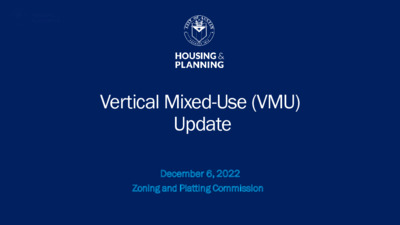16 B VMU Update Presentation.pdf — original pdf
Backup

Vertical Mixed-Use (VMU) Update December 6, 2022 Zoning and Platting Commission Overview VMU Background VMU Participation Data VMU-2 Amendments Questions 2 Vertical Mixed-Use (VMU) Austin needs 135,000 new housing units by 2025 to keep pace with population growth The market is not providing adequate housing for low-income and moderate-income people Affordable housing is not equitably distributed throughout the city The cost to close the gap in low-income housing in Austin was estimated at over $11 billion in 2017 3 Vertical Mixed-Use (VMU) VMU is a voluntarydensity bonus program designed to generate community benefits through the use of development incentives. Development Incentive Community Benefit Adopted in 2010 – Included a one-time opt-in/opt-out process for neighborhood associations or neighborhood planning teams Applicable along 2010 “core transit corridors” – Connects housing and services to transit – May also include other roadways based on original neighborhood opt-in process Offers development incentives in exchange for community benefits – Improves flexibility for site development – Creates enhanced pedestrian environment – Regulates affordability – Support sustainable development patterns Site Development Flexibility Reduced Parking Requirement No FAR restrictions Additional Allowable Uses Regulated Affordability Heightened design standards Mix of land uses Active ground floor use 4 Our Toolkit • Local Funding • Federal Funding • Density Bonus • Fee Waivers • Regulations • Subsidize Affordable Housing • Incentivize (Affordable) Housing Current Density Bonus Programs • Citywide: – SMART Housing – Affordability Unlocked • Geographically Specific: • Downtown (+ Rainey) Density Bonus • East Riverside Corridor Regulating Plan • North Burnet Gateway Regulating Plan • Transit Oriented Development Regulating Plans • Plaza Saltillo, MLK, North Lamar/Airport • University Neighborhood Overlay • Vertical Mixed-Use (VMU) • Planned Unit Developments (PUD) 6 Key Strategies: • Market Austin’s 10-Year Affordable Housing Goals 135,000 Units in 10 Years Key Strategies: • Federal funding • Local funding Key Strategies: • Federal funding • Local funding • Density Bonus Programs Key Strategies: • Density Bonus Programs • Strike Fund • Other Incentives Key Strategies: • Strike Fund • LDC Revisions VMU Combining District Example Zoning String: CS-MU-V-CO-NP VMU-Zoned Sites Base Zones Description Max Height % of Sites Impervious Cover CS commercial services GR community commercial LO limited office neighborhood commercial general office neighborhood office LR GO NO 60ft 60ft 40ft 40ft 60ft 35ft 95% 90% 70% 80% 80% 60% 67% 18% 5% 5% 3% 1% 8 Dispersion of VMU Zoning VMU Zoning Total Sites with -V Total Acres with -V ~ 818 ~ 1,900 8 5 9 VMU Site Development Standards •Same as base zoning •Compatibility standards supersede •Same as base zoning •No minimum front or side setbacks •Compatibility standards supersede •Height and Impervious Cover still provide site controls Building Height Impervious Cover Reduced Setbacks No Floor to Area Ratio (FAR) limit •Up to a 60% reduction •Allows residential uses in the minimum number of required parking spaces Reduced Parking Requirement in commercial and office zones •Allows additional commercial uses in office zones Broader Range of Allowed Uses •Pedestrian-Oriented Commercial space requirement on first floor •Minimum of one floor of residential use required Mix of Uses Required 10 Affordable Housing Created by Density Bonus Program Participation 1,400 1,200 1,000 800 600 400 200 0 Downtown + Rainey East Riverside Corridor 138 0 North Burnet Gateway 190 31 TODs 233 362 University Neighborhood Overlay 195 1,092 Vertical Mixed-Use (VMU) 549 657 Planned Unit Development s (PUD) 5 317 Under Construction Completed 40 30 Fees In-Lieu Generated or Anticipated $13,023,005 - $7,680,623 $5,371,226 $3,627,211 - $2,061,917 11 Vertical Mixed-Use (VMU) Program Participation In Planning Under Construction Completed Possible Combined Impact VMU Projects 25 11 37 VMU Housing Units 6,345 2,563 6,793 Income-Restricted Affordable Housing Units Tenure of VMU Housing Units 641 549 657 Rental Ownership 100% 0% 98% 2% 95% 5% data source: Affordable Housing Inventory (accessed 4/18/22) 73 15,701 1,868 97% 3% 12 Previous VMU Requirements: VMU1 Buildings Rental Developments 40-year affordability period For-Sale Developments 99-year affordability period 10% set-aside affordable to households earning not more than 60% Median Family Income Or 80% Median Family Income (Varies by neighborhood) 10% set-aside affordable to households earning not more than 80% Median Family Income and 100% Median Family Income (5% at each level) 2021 Median Family Income Limits (Austin Area) 1 Person Household 2 Person Household 3 Person Household 4 Person Household 60% MFI 80% MFI 100% MFI $41,580 $55,400 $69,250 $47,520 $63,300 $79,100 $53,450 $71,200 $89,000 $59,340 $79,100 $98,900 Average Affordable Rental Limit Typical Affordable Home Sales Price (1 Bedroom) 60% MFI 80% MFI 100% MFI $1,077 $1,436 $219,800 $273,400 13 Recent VMU Updates: VMU2 Buildings VMU1 Buildings Bonus Entitlements Rental Developments 40-year affordability period For-Sale Developments 99-year affordability period • Residential uses • Unlimited FAR • Waiver of site dimensional requirements 60% reduction in parking minimum • 10% set-aside as affordable to households earning no more than 60% Median Family Income 10% set-aside as affordable to households earning no more than 80% Median Family Income OR Fee equivalent to 10% of total units VMU2 Buildings • All of the above • 30ft bonus height 10% set-aside as affordable to households earning no more than 50% Median Family Income OR 12% set-aside affordable to 60% Median Family Income 12% set-aside affordable to households earning no more than 80% Median Family Income OR Fee equivalent to 12% of total units 14 Challenges Opportunities Only works in areas with high market demand Create income-restricted affordable housing without requiring direct public subsidy Barriers to securing long-term affordable homeownership housing units Increasing housing supply with bonus market-rate housing Feasibility reduced by competing regulations that inhibit design and construction Improves transportation choice by locating housing and other services near transit Was not created with racial equity at the forefront Supports Climate Equity goals for land use and transportation 15 Questions